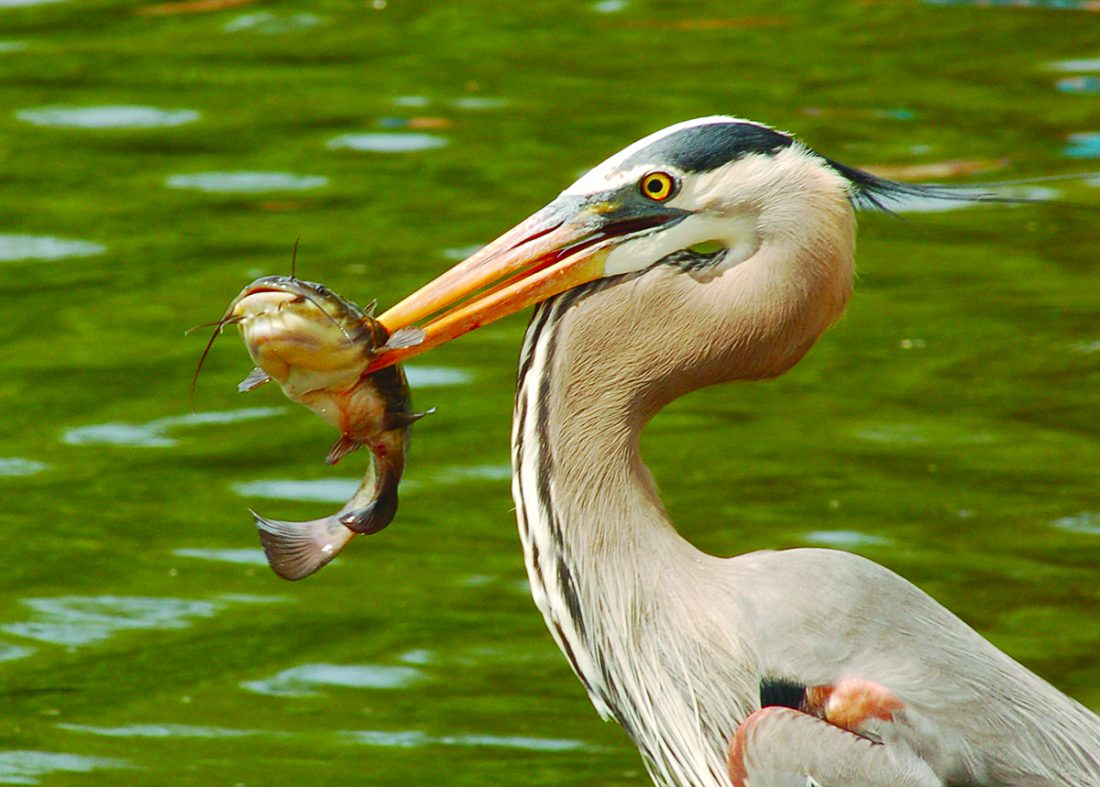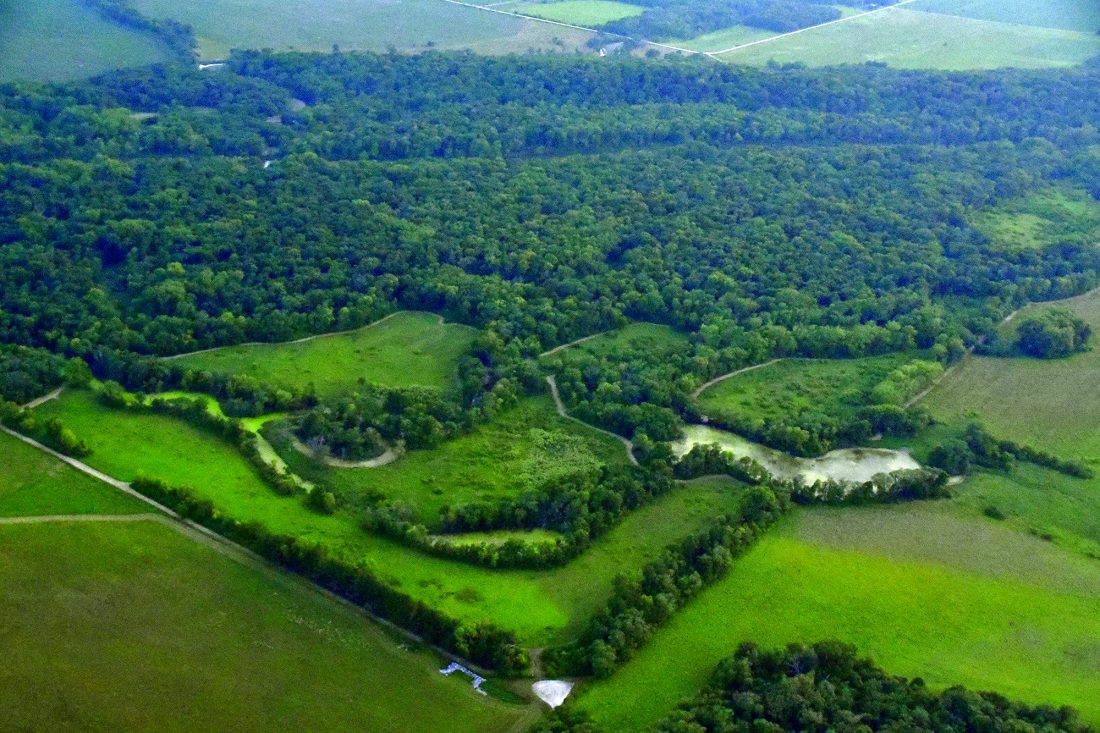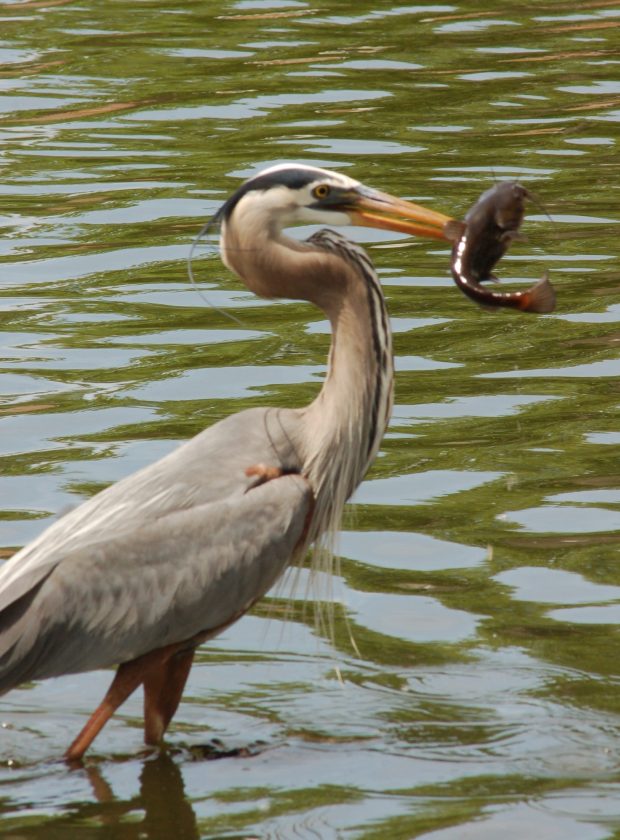Water and wildlife at Arney Bend

Photos by Garry Brandenburg – A great blue heron finds these backwater environments an excellent place to hunt for fish. Wood ducks love this environment. Deer abound and wild turkeys find the woodlands an excellent place to live.
BEAVER (Castor canadensis) are one of our common species of wildlife, seldom seen due to their underwater wandering and propensity to conduct activities at night time. The evidence of their existence can be seen by humans during daytime excursions into a place like the Arney Bend Wildlife Area. One can also find beaver dams, small, medium or large, on some small tributary creeks. Local willow trees, cottonwoods and sometimes crop fields become the source of foods these furry creatures are looking for. And behind a beaver dam, impounded water creates habitats for all kinds of aquatic life. Ponds created by backed up waters allow for underwater entrances to their bank dens. It is not typical here in central Iowa to see a large mound or island of sticks amassed in the middle of a pond.
On one of my recent walk-abouts in Marshall County, I chose to hike into the Arney Bend Wildlife Area. It was back in 1980 that I helped get the ball rolling for eventual official action by the Marshall County Conservation Board to purchase a 203 acre river bottom forest area, a portion of the Iowa River Greenbelt, in order to facilitate a conservation area addition. This area lies adjacent to the Iowa River, on the east side of the river. To the west side of the river lies private land known as Mormon Ridge.
Now back to my observations while on my exploratory hike. I found lots of water in the first big oxbow lake (former river channel of ancient times). My first impression was that not enough rain had fallen this spring to account for a full to slightly overfill water level. I continued by hiking along once familiar trails and found more water, this time enough that a normal dry land passage required finding grass tufts big enough to use as “stepping stones” to cross. And then at the next normally dry crossing point, I found too much water. The reason was now obvious….beaver activity had plugged a culvert. Water could not drain. Therefore the old river oxbow was full of water, a temporary oasis in the middle of our mini-drought.
This 203 acre site was made possible by securing a grant from the Wildlife Habitat Stamp fund. The year was 1980. Hunters are aware of this provision of Iowa law that goes along with one’s purchase of annual hunting licenses. A small fee attached to that license purchase is deposited into a state-wide habitat fund account. When a likely project acquisition needs financial help to make the purchase, a competitive grant application process annually reviews all submitted projects, and if successful, will help pay 75 percent of the cost. The other 25 percent must come from local funds, either part of the conservation board budget and/or a local fundraising endeavor involving many stakeholders who make donations for the cause. A big thank you is still in order to an endowment account from the Izaak Walton League of America and the Iowa Division of the Ikes to secure significant donations. Long story made short, that is how Arney Bend Wildlife Area came to be.
Beaver activity anywhere along and adjacent to the Iowa River varies year to year. They will always be with us, helpful habitat creators on the one hand and yes, in the wrong place, a nuisance to farmland owners. If only beavers would cooperate. That is easier said than done. So our situation is to adapt and learn to live with this animal, control what we can and allow these big rodents to have places of their own where the web of life can continue because of the beaver.

Today’s image of the Arney Bend Wildlife Area was made July 3rd from the vantage point of an airplane at 1,000 feet above the ground. The advantage of being high above the ground allows one to see how the land, its grassland/prairie fields and water areas intermingle to form a wildlife friendly complex. The ponds at Arney Bend are remnants of old Iowa River channels from centuries ago. And now with the assistance of a common mammal, a big rodent to be specific, the beaver, water has been impounded to retain a wetland status. In an anthropomorphic way of thinking, people could assume that Mother Nature uses methods unknown to us to instruct beaver families on how to preserve water during dry times of the year.
Beavers are one of the few animals that can and do modify their habitat by building watertight dams of sticks, woven with reeds, branches and saplings and all packed well with mud. Beaver dams hold water during heavy rainfall events, preventing or slowing runoff water. Beavers are herbivores, eating leaves, woody stems and aquatic plants. A primary building material and preferred foods include polar, willow, birch, maple and cottonwood. During a cold winter, they spend time inside a bank den lodge, feeding on branches they stored up last summer. And while outside activity is much lower, they survive. Mother Nature’s water engineers will live on long into the future.
Another observation of mine while at Arney Bend is that numerous trees reminded me of temporary tree stands I had placed here and there over the years so that each fall at archery season, I could climb into a stand and wait for deer to pass by. Typical for tree stands is the fact that on any particular day may or may not be the time when a deer passes by on a nearby trail. While every hunt and every tree stand time spent may not Bhave had a deer sighting, it was still a successful hunt and time well spent. Each tree I noted that once held a tree stand did offer deer sightings and archery shot opportunities eventually. I just changed tree stand locations as each year passed. I also lost count of the different trees that once held a stand. This process of tree stand locations allowed me to get to know the landscape and cover every inch of this 203 acre wildlife area. Memories abound by the good times I spent exploring this natural area. Many other folks, hikers, photographers, mushroom seekers, duck and goose hunters and deer hunters have experienced the same satisfactions by utilizing a place like Arney Bend.
HUNTER SAFETY CLASS online registration is now available for our local area. A normal class structure will be returned to when the class begins on Aug. 26, a Thursday evening from 6 to 9 p.m., and Aug. 28 from 8 a.m. until 4 p.m. Live fire of shotguns and .22 rifles will be reinstated. Live fire was cut last year due to COVID-19 restrictions. That is history now so it is back to normal.
Hunter safety class instruction is required for anyone born after Jan. 1, 1972. By taking the class, and becoming certified, the young boy or girl is then eligible to purchase a hunting license once they turn age 16. To register, one can sign up the young person, minimum age of 12, by going to license.gooutdoorsiowa.com.
The Marshall County Izaak Walton League is located at 2601 Smith Ave., Marshalltown, IA 50158. A general direction to get to the Ikes is to take Iowa Avenue east to Smith Ave, then go south two miles to the Ikes grounds located on the west side of the road. Lunch will be provided. Participants need to dress for the weather since much of the class itinerary will be outside. There will be indoor classroom presentations also. Attendance at both Thursday evening and all day Saturday is required. Once a person is certified into hunter safety in Iowa, every other state will honor that certificate. It opens the door to hopefully many decades of outdoor exploration and enjoyment using hunting and shooting sports.

FACT: Hunters are a driving force behind conservation in North America. They have facilitated the recovery of dozens of game animals by protection of wildlife habitats across the continent. The North American Model of Wildlife Conservation is entirely based on the foundation of sustainable-use hunter conservationists.
Garry Brandenburg is the retired director of the Marshall County Conservation Board. He is a graduate of Iowa State University with a BS degree in Fish & Wildlife Biology.
Contact him at:
P.O. Box 96
Albion, IA 50005
- Photos by Garry Brandenburg – A great blue heron finds these backwater environments an excellent place to hunt for fish. Wood ducks love this environment. Deer abound and wild turkeys find the woodlands an excellent place to live.
- Today’s image of the Arney Bend Wildlife Area was made July 3rd from the vantage point of an airplane at 1,000 feet above the ground. The advantage of being high above the ground allows one to see how the land, its grassland/prairie fields and water areas intermingle to form a wildlife friendly complex. The ponds at Arney Bend are remnants of old Iowa River channels from centuries ago. And now with the assistance of a common mammal, a big rodent to be specific, the beaver, water has been impounded to retain a wetland status. In an anthropomorphic way of thinking, people could assume that Mother Nature uses methods unknown to us to instruct beaver families on how to preserve water during dry times of the year.









